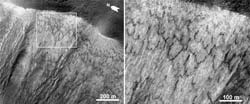Is there life on Mars?

A new study reveals that parts of Mars may have been modified by liquid water in recent geologic times, which might indicate more favourable conditions for life on the planet. Photo: University of Gothenburg<br>
Carried out by researchers from the University of Gothenburg, Sweden, in conjunction with German planetary researchers at Wilhelm’s University in Muenster and the Germany Aerospace Center (DLR) in Berlin, the study have now been published in the prestigious journal ICARUS, the International Journal for Solar System Studies.
The surface of Mars displays a diverse landscape, and a new study shows that large areas of the northern hemisphere have undergone a number of freeze-thaw cycles.
“This process is common in our own Arctic permafrost environments and causes the formation of lobate features on slopes,” says Andreas Johnsson at the University of Gothenburg’s Department of Earth Sciences. “As the Martian landscapes we’re studying feature ground-ice, our interpretation is that liquid water has been available in the ground during thaw periods.”
Gullies formed by water
When the ice melted, the near-surface sediment on the slopes became saturated with the melt water and then slowly began to move downwards on top of the still frozen permafrost table due to gravity.
“You can see these structures in close proximity to what are known as gullies,” says Andreas Johnsson.
The researchers have long suspected that the gullies, which are geologically young landforms, were formed by liquid water.
“Our question was: if liquid water can occur in local niches, predominantly in impact craters, where most of the gullies are to be found, then shouldn’t we see more signs of thawing and the effects of melt water, along the lines of those in our own Arctic environments?”
In the study, which focuses on the northern hemisphere of Mars, the researchers could see lobate features in close proximity to the gullies. Morphologically similar landforms are also to be found in Arctic areas on Earth, and are known as solifluction lobes.
Comparisons with Earth
In the study, the researchers compared Martian landforms with known solifluction landforms in Svalbard.
“Unlike local ice-melting, as suggested by the ravines, the solifluction lobes indicate that there has probably been more widespread thawing of the Martian landscape,” says Andreas Johnsson. “Consequently there must have been liquid water in large areas, which is interesting for our understanding of past climates.”
The results show either that the climate models for Mars must be fine-tuned to include the climatic conditions required by these features, or that there is another factor at play.
Since the Mars Phoenix Lander mission it has been confirmed that the ground contains salts that can affect the freezing point of water on Mars so that it can be liquid even at sub-zero temperatures and low atmospheric pressure.
“We don’t yet know which of these scenarios is more likely − it could be a combination of the two.”
Searching for life on Mars
Transient liquid water is also of considerable interest when looking for favourable environments for life on Mars. Research has shown that organisms can survive for long periods without water in cold environments on Earth, but that there must be access to water at times.
“On Mars, these landforms may suggest that the ice melts during favourable “warm” periods and the ground is temporarily saturated with water before freezing again when a new cold period comes along. This process is probably seasonal and linked to periods when Mars’ polar axis was more tilted. Given the varying climate on Mars, it is possible that these conditions are recurring. It has to be emphasized, however, that process-landform interpretation can be problematic due to convergence, which means that different sets of processes may result in similar-looking landforms. Nevertheless, based on comparative morphology, morphometry relationships and the proximity to gullies make these landforms consistent with solifluction”.
The study has been published in the prestigious journal ICARUS, the International Journal for Solar System Studies.
Bibliographic data
Titel: Periglacial mass-wasting landforms on Mars suggestive of transient liquid water in the recent past: Insights from solifluction lobes on Svalbard
Authors: Johnssona,Reiss,Hauber,Zanetti,Hiesinger,Johanssona,Olvmo
Journal: Icarus, Volume 218, Issue 1
For more information, please contact: Andreas Johnsson, doctoral student in physical geography, Department of Geosciences, University of Gothenburg
Telephone: +46 (0)31 786 2943
Mobile: +46 (0)725 205 088
E-mail: andreasj@gvc.gu.se
Media Contact
All latest news from the category: Earth Sciences
Earth Sciences (also referred to as Geosciences), which deals with basic issues surrounding our planet, plays a vital role in the area of energy and raw materials supply.
Earth Sciences comprises subjects such as geology, geography, geological informatics, paleontology, mineralogy, petrography, crystallography, geophysics, geodesy, glaciology, cartography, photogrammetry, meteorology and seismology, early-warning systems, earthquake research and polar research.
Newest articles

Machine learning algorithm reveals long-theorized glass phase in crystal
Scientists have found evidence of an elusive, glassy phase of matter that emerges when a crystal’s perfect internal pattern is disrupted. X-ray technology and machine learning converge to shed light…

Mapping plant functional diversity from space
HKU ecologists revolutionize ecosystem monitoring with novel field-satellite integration. An international team of researchers, led by Professor Jin WU from the School of Biological Sciences at The University of Hong…

Inverters with constant full load capability
…enable an increase in the performance of electric drives. Overheating components significantly limit the performance of drivetrains in electric vehicles. Inverters in particular are subject to a high thermal load,…





















